Last Updated on February 23, 2025 by Owen McGab Enaohwo
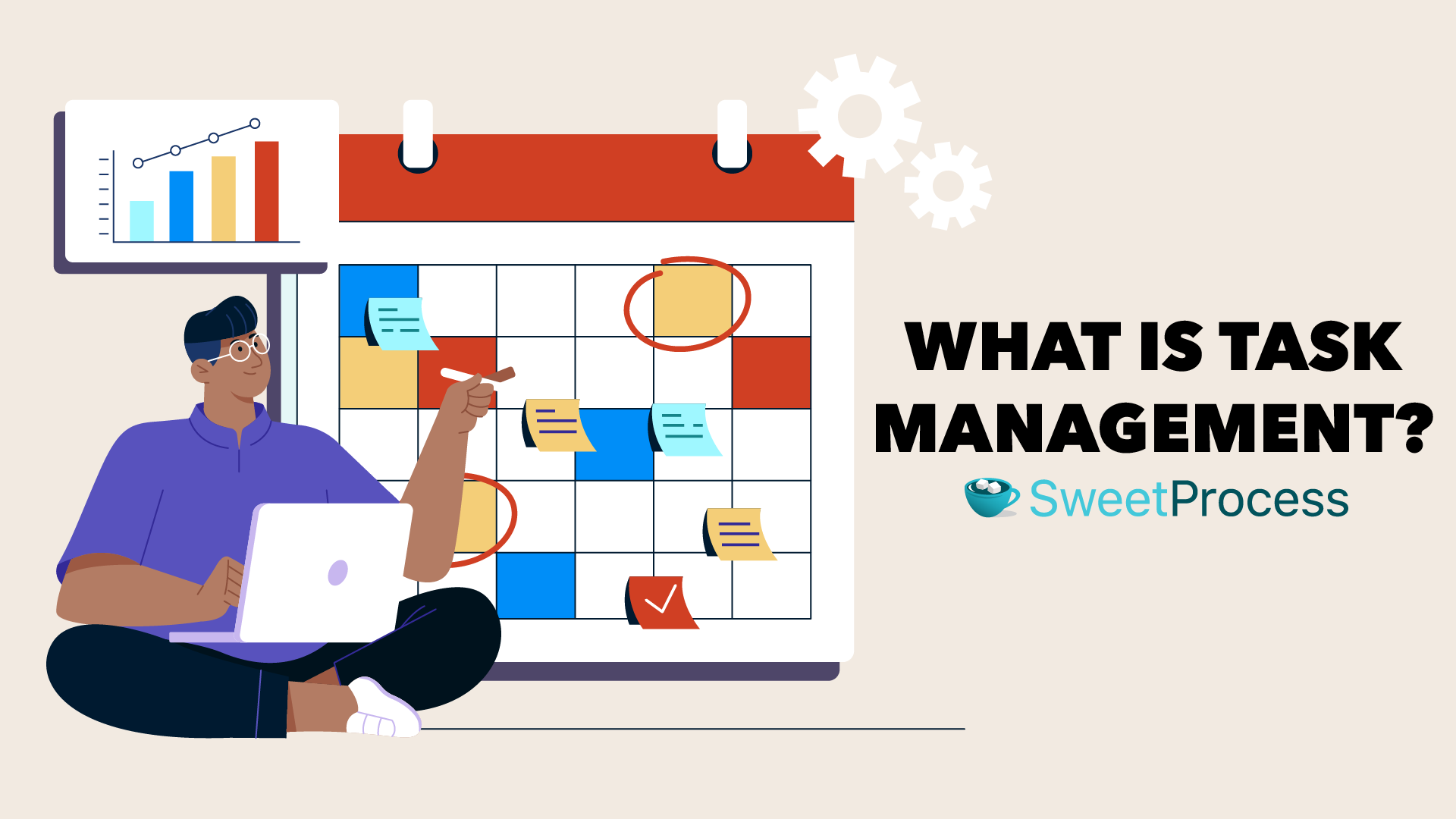
Managing a large or remote team can be challenging. One minute, you think you’ve got everything under control, and the next minute, deadlines slip through your fingers.
You might think there has to be a better way to keep track of everything without losing my sanity. It’s not enough to tick off items on a to-do list; you need to create a system that works for you and your team.
Systems backed with the right tool for implementation can make all the difference. You should, therefore, seek better ways to manage your team and work smarter. According to a survey by The Alternative Board, 72% of small business owners already feel overwhelmed with their roles. This means that there is a dire need to make changes to how you work and manage your team. A few smart strategies can transform chaos into order. In this article, we’ll dive into practical tips, essential tools, and the benefits of mastering task management that ensure everything runs smoothly.
Ready to reclaim your time and boost your productivity? Discover how SweetProcess can help you streamline your tasks and transform your workflow. Start your 14-day free trial and take the first step toward a more organized, efficient business.
Task Management: The Ultimate Guide to Getting Things Done More Effectively – Chapter Index
How to Manage Tasks Effectively: A 5-Step Guide
How to Manage Your Company’s Tasks Using SweetProcess
Benefits of Task Management in an Organization
13 Practical Tips & Best Practices to Manage Your Tasks Effectively
7 Best Task Management Software & Tools
7 Effective Task Management Techniques & Strategies for Success
9 Key Steps in the Task Management Process
Task Management vs. Project Management: How They Differ
Manage Your Company’s Tasks Effectively Using SweetProcess
What is Task Management?

Task management is the process of managing tasks through their lifecycle. Typically, task management involves several key activities. It starts with identifying and organizing tasks and setting priorities and deadlines. It also includes managing task tracking, task dependencies, and resources, ensuring effective collaboration and communication among team members, and tracking task performance to identify areas for improvement.
Task management is essential for maintaining order and efficiency in a company setting. Think of it as the backbone of your daily operations. Without it, you’d be swimming in a sea of chaos, with deadlines slipping through the cracks and projects stalling. Task management ensures that every task, no matter how small, is accounted for and completed on time.
It streamlines workflows, boosts productivity, and ensures everyone is on the same page. Whether running a small business or managing a large team, mastering task management can make all the difference.
How to Manage Tasks Effectively: A 5-Step Guide

Managing your tasks effectively requires following a step-by-step process to get your tasks completed on time. Here are the steps to take:
Step 1: Create and Organize Tasks
Start by listing and documenting all the tasks that need to be done. Use a to-do list template, spreadsheet, or task management software. The goal is to get everything out of your head and into a system. This step is crucial for visualizing your workload and planning your next moves.
Step 2: Set Priorities and Deadlines
Once you have your tasks listed, it’s time to prioritize. Not all tasks are created equal. Some need immediate attention, while others can wait. Assign deadlines to each task based on their urgency and importance. This helps you focus on what matters most and ensures you meet critical deadlines.
Step 3: Manage Task Dependencies and Resources
Sometimes, certain tasks depend on each other. One task might need to be completed before another can start. Identifying these dependencies early on prevents delays and keeps the project moving smoothly. Similarly, allocating the right resources, be it time, tools, or people, ensures that tasks are completed efficiently.
Step 4: Collaborate and Communicate With Team Members
Effective communication is the secret to task management. Regular check-ins and updates ensure everyone knows what’s happening and what’s expected of them. You can use collaboration tools to share updates, ask questions, and provide feedback. The aim is to create a cohesive team working toward the same goal.
Step 5: Track and Analyze Task Performance
Finally, you need to monitor task progress. Tracking performance helps you identify what’s working and what’s not. You can use analytics to understand bottlenecks and make data-driven decisions.
These steps can help you transform your approach to task management and boost your team’s productivity.
As your company grows, the tasks also become more numerous and complex. Hence, finding and using the right tool for task management becomes crucial at this point. In the next section, we’ll see how SweetProcess can make this more accessible.
How to Manage Your Company’s Tasks Using SweetProcess

When you have a large team or complex processes and procedures with many moving parts, it can become chaotic and overwhelming. You now have so many tasks to manage and work efficiently. SweetProcess simplifies task management, making creating, assigning, and tracking tasks easy, ensuring nothing slips through the cracks.
Let’s dive into how to use SweetProcess to manage your tasks:
Sign up and Get Started
The first step is to sign up on the SweetProcess platform. SweetProcess offers a 14-day free trial, allowing you to explore its features without any initial investment.

Once you sign up, you’ll gain access to your dashboard, where you can manage tasks immediately. Tasks associated with existing procedures or processes can also be assigned accordingly.
Create a Task for Your Team Members
Creating a task on SweetProcess is straightforward. From your dashboard, navigate to the “Task” tab and click “Assign Task” on the right.

A pop-up appears where you must enter the task details, including the task name, description, due date, frequency, and priority level. Then, assign the task to the appropriate team member to complete the process.

Note that only users on SweetProcess with manager-level access can assign tasks to others. But you can set the option to permit other teammates to assign tasks.
Assign a Procedure to a Team Member as a Task
Procedures are essential for maintaining consistency and quality. On SweetProcess, you can easily assign procedures as tasks. To do so, navigate to the “Procedures” tab on your dashboard.

From the list of existing procedures, click the three dots to the right of the procedure to be assigned.

Next, click “Assign” and select the team member needed for the task. Add the due dates and reminders and complete the process.
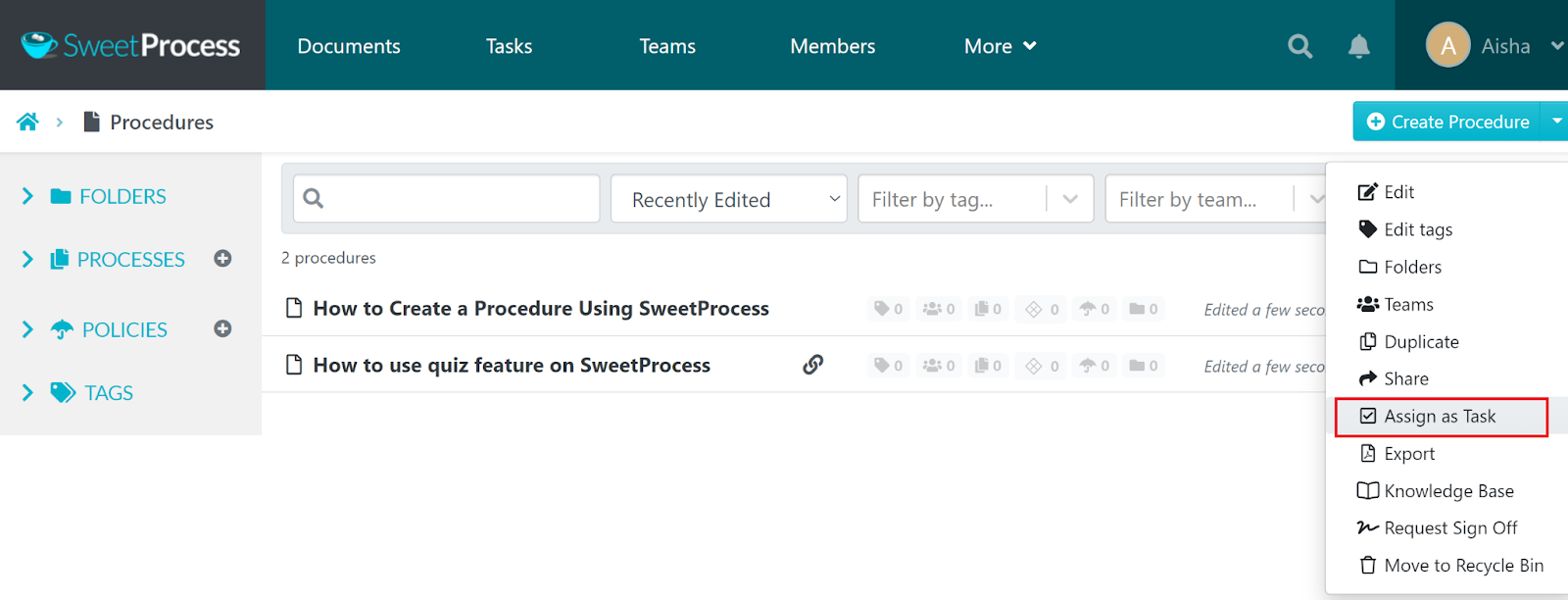
Your tasks can also be assigned directly from the procedure while it is open from the “Actions” menu on the top right of the screen:

Tasks can be assigned to a single team member or an entire team.

Tasks assigned properly help ensure everyone follows the correct steps, reducing errors and improving efficiency.
Assign a Process to a Team Member as a Task
Processes often involve multiple steps and require coordination among various team members. SweetProcess allows you to assign entire processes as tasks following similar steps for assigning procedures described above.
To do this, navigate to the “Processes” tab on your dashboard. Choose the process you want to assign and allocate it to a team member using the steps described above for assigning a procedure.

Assign Tasks Based on Roles
SweetProcess also offers the flexibility to assign tasks based on team members’ roles. This feature is handy for larger teams with specialized roles.
Once you have created your processes or procedures, you can select any of them and assign them directly to a team member straight from the dashboard.
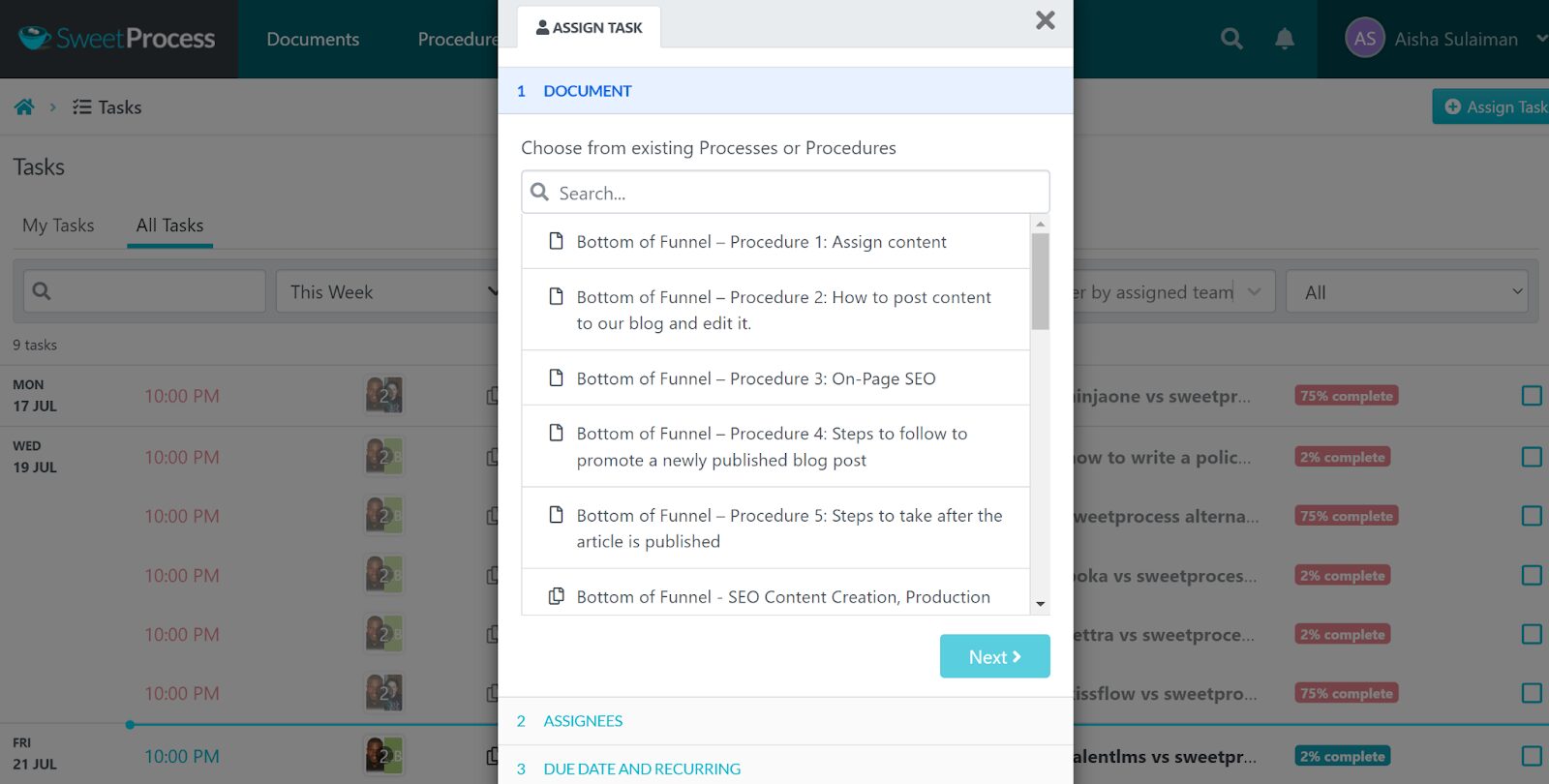
After selecting the process or procedure, you can add team members in the next step. This displays a list of assignees, which you can add accordingly.
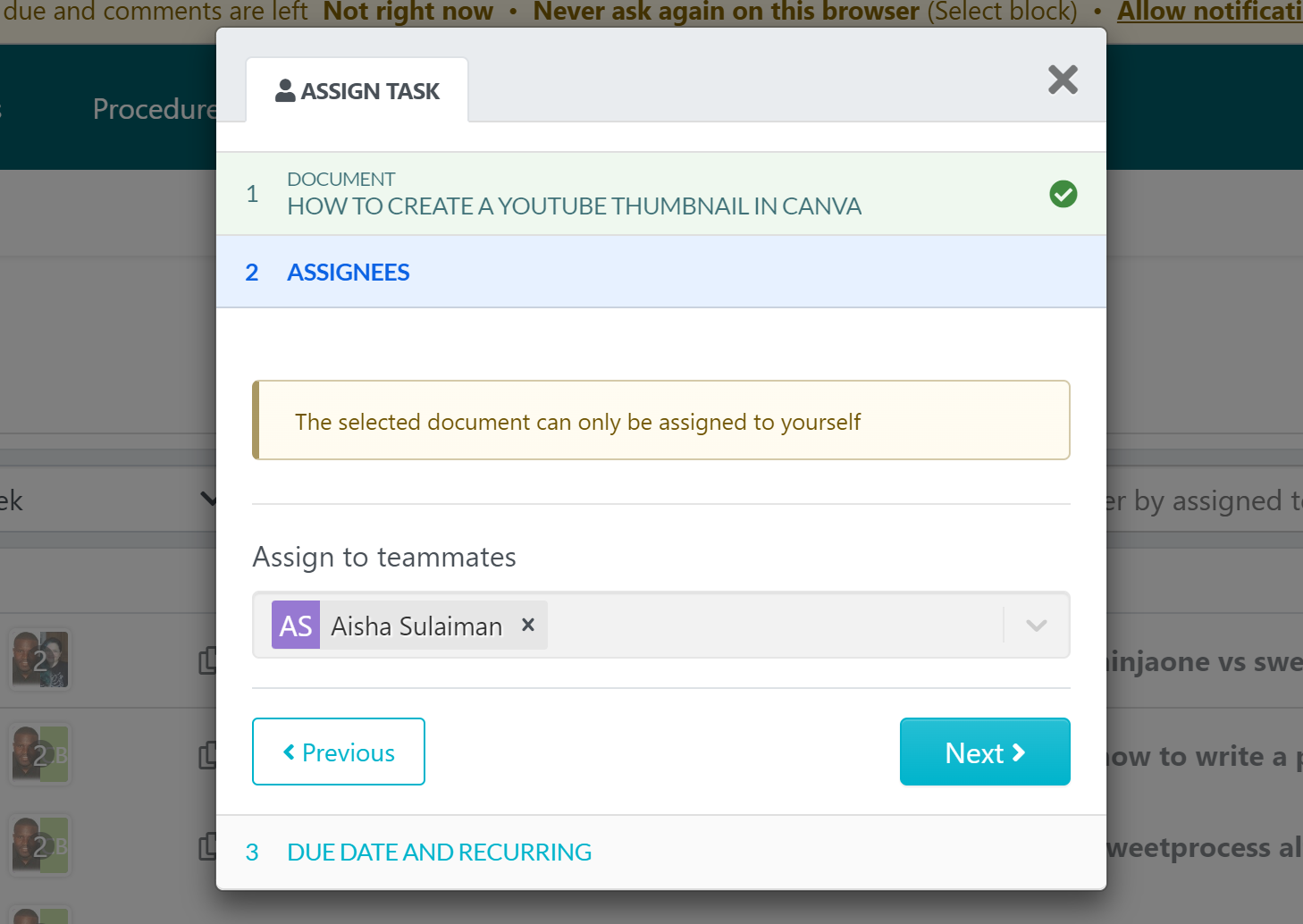
Once completed, you can add due dates and reminders to complete the process.

By assigning tasks according to each team member’s role, you can ensure that the right people are working on the right tasks, maximizing efficiency and leveraging each member’s expertise.
Assign Tasks Based on Teams
Sometimes, tasks need to be handled by specific teams rather than individuals. SweetProcess again supports assigning tasks to entire teams. This is useful for collaborative projects that require input from multiple team members.
Simply select the team to which you want to assign the task, and all team members will be notified when you do so.
Manage a Task
Once tasks are created and assigned, managing them is crucial, and SweetProcess makes this seamless. You can update task details, change priorities, and track progress directly from your dashboard.
On the dashboard, you have an overview of all pending tasks. You can also see tasks assigned to you alone. Each task displays the due date and accompanying percentage of completeness to give you a broad overview of how best to manage due dates.
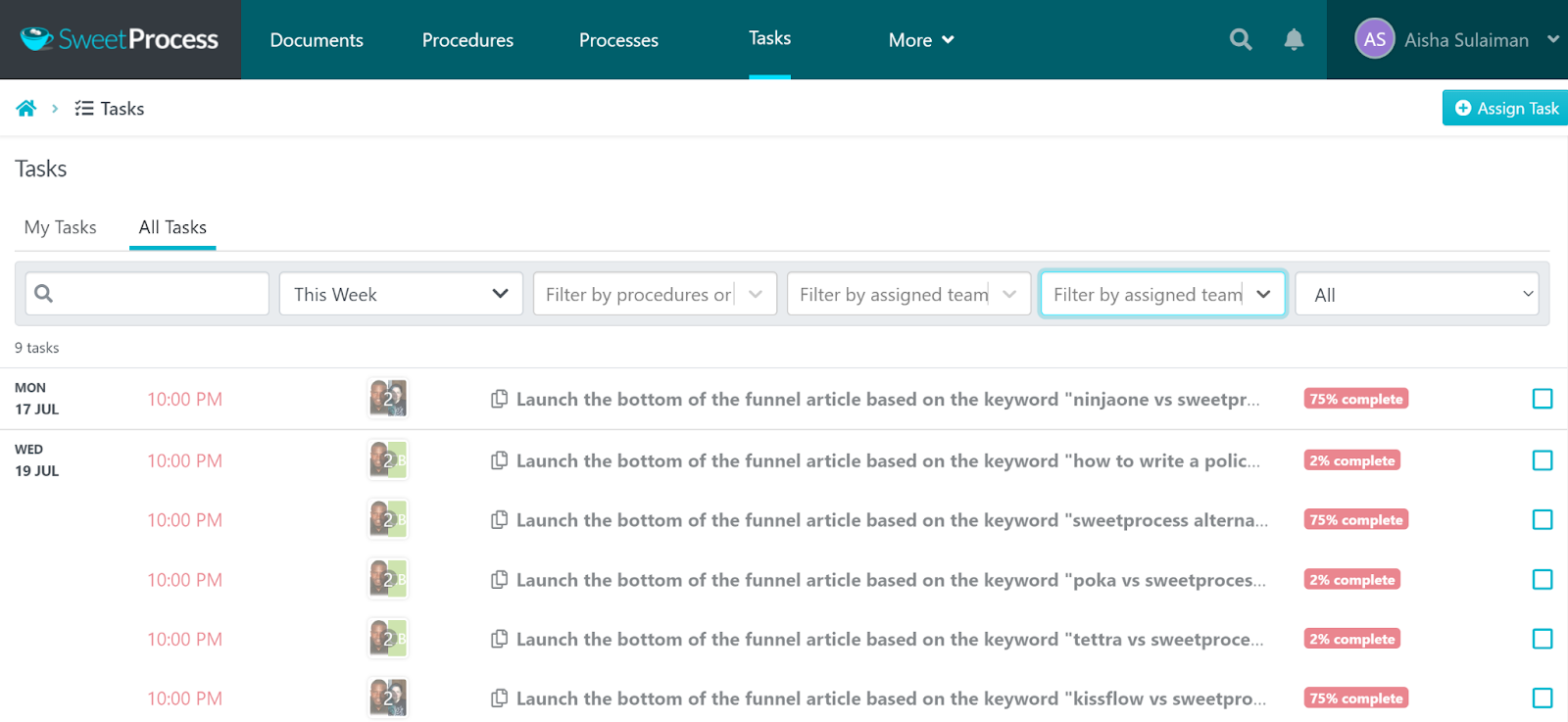
Each task displays the person it was assigned to and the steps required to complete it. You can use the search filter to find specific tasks sorted by due dates.
This central management hub ensures you always have a clear overview of what’s happening, and you can make adjustments as needed.
Set Reminders for Tasks
Never miss a deadline again with SweetProcess’s reminder feature. You can set reminders for tasks to ensure they are completed on time. You can choose when and how often to receive reminders, keeping everyone on track and accountable.
You can also add a specific due date and reminders when setting up a particular task. This will help to follow up on the team members assigned to ensure they do not miss deadlines.

The reminder can be set to send single or multiple reminders, depending on the duration or timeline assigned to the task.
Track Assigned Tasks to Employees
Monitoring your team’s progress is crucial for keeping projects on schedule. With SweetProcess, you can easily track tasks assigned to employees and provide real-time updates on their status.
The dashboard provides an overview of all assigned tasks and helps the project manager keep track of deadlines. As an individual, you can also see what’s on your plate and prioritize accordingly.

This visibility helps you identify potential bottlenecks and take corrective action before they become major issues.
SweetProcess can transform and improve your processes when used correctly. But don’t just take our word for it—see how SweetProcess has made a difference for other companies.
Independent Retirement significantly improved its operations by using SweetProcess for effective process documentation. This shift enabled them to scale efficiently and support growth, providing a clear roadmap for every task and procedure.
Simple Solutions faced the challenge of costly mistakes impacting service quality. Adopting SweetProcess streamlined their tasks, reduced errors, and enhanced their service delivery. Precise task management led to fewer mistakes and higher customer satisfaction.
CFO Services Group struggled with tribal knowledge, with important information being held by a few key employees, thus hindering easy access. SweetProcess helped them document these essential processes, ensuring that the required knowledge was accessible to the entire team. This documentation not only preserved vital information but also improved overall efficiency.
These examples illustrate how effective task management can drive success. SweetProcess offers the tools to organize, track, and manage tasks effortlessly, ensuring your team operates like a well-oiled machine.
You can sign up for the 14-day free trial on SweetProcess and experience how easy it is to create and manage tasks effectively.
Benefits of Task Management in an Organization

Effective task management can lead to transformative results with your team members. Here are the benefits of having effective task management in place.
Boosts Team Productivity and Efficiency
Imagine your team operating at peak efficiency, with each member knowing exactly what to do and when. Task management makes this a reality by providing clear instructions, priorities, and deadlines. By eliminating guesswork and streamlining processes, your team can focus on what they do best: driving results and growth.
Promotes Communication and Collaboration Among Team Members
Communication breakdowns can derail even the best-laid plans. Task management fosters better communication and collaboration by providing a centralized platform for updates, feedback, and information sharing. No more lost emails or missed messages—everyone stays in the loop, ensuring the team moves forward together. This improved communication helps in building a stronger, more cohesive team dynamic.
Helps Team Members Stick to Deadlines
Deadlines are the backbone of productivity. A task management solution helps team members stay on track by setting clear deadlines and providing reminders. It’s like having a personal assistant for each task, ensuring that nothing slips through the cracks. By keeping everyone accountable and aware of their responsibilities, you’ll significantly reduce missed deadlines and last-minute scrambles.
Helps to Identify Bottlenecks in a Team
Task management can help identify bottlenecks and inefficiencies holding your team back. By tracking task progress and analyzing performance, you can pinpoint problem areas and address them before they escalate. This proactive approach keeps your projects on track and ensures smoother workflows.
Provides a Better Overview of Your Ongoing Projects
Keeping track of multiple projects can sometimes be overwhelming. Task management provides a bird’s-eye view of all ongoing projects, allowing you to monitor progress, allocate resources, and adjust priorities as needed.
Keeps Your Team Members on the Same Page
Task management ensures that everyone knows their role and responsibilities. Providing clear instructions and regular updates keeps all team members aligned and focused on common goals. It also reduces confusion and misunderstandings, fostering a more efficient and harmonious work environment.
Task management isn’t just a tool; it’s a strategy that can revolutionize your business. In the next section, we’ll cover the tips and best practices you can adopt in your organization for proper task management.
Are you ready to experience these benefits firsthand? Sign up for the 14-day free trial of SweetProcess and see how effective task management can transform your business.
13 Practical Tips & Best Practices to Manage Your Tasks Effectively

Managing tasks can be an uphill battle. One wrong move and everything comes crashing down. But with the right strategies, you can turn that elusive chaos into a well-ordered system. Here are 13 practical tips and best practices to help you keep things running smoothly and effectively.
Eliminate Distractions
Distractions are productivity killers. Eliminating distractions is a must, whether it’s the constant ping of notifications or the lure of social media. Try setting specific times to check emails and turn off unnecessary notifications. Creating a distraction-free zone can make a huge difference in your focus and efficiency.
Set SMART Goals
Goals without clarity are like a ship without a compass. Set SMART goals that are specific, measurable, achievable, relevant, and time-bound. This approach gives you a clear direction and tangible targets to aim for, making tracking progress and achieving your objectives easier.
Create an Effective Schedule
An effective schedule is the backbone of good task management. You can plan your day in advance, allocating time slots for different tasks. Use tools like calendars and planners to visualize and stick to your schedule. Remember, a well-structured day leads to better productivity and less stress.
Break Tasks Down
Large tasks can appear cumbersome. Breaking them into smaller, manageable chunks makes them less daunting and more achievable. It’s like eating an elephant: one bite at a time. This approach also helps maintain focus and momentum as you tackle each small task.
Focus on One Task at a Time
Multitasking might seem efficient, but it often leads to mistakes and lower-quality work. Focusing on one task at a time enhances your productivity and the quality of your work. Use techniques like time blocking to dedicate specific periods to single tasks, reducing the temptation to juggle multiple tasks simultaneously.
Delegate Tasks
You don’t have to do everything yourself. Delegate tasks to team members with the skills and capacity to handle them. This lightens your load, empowers your team, and builds trust.
Prioritize Tasks
Not all tasks are created equal. Use a prioritization method like the Eisenhower Matrix to determine which are urgent and which are important. Focus on these first and tackle less critical tasks later. This ensures that you’re always working on what matters most.
Batch Your Tasks
Batching similar tasks together can save time and mental energy. For example, set aside a specific time for answering emails, another for meetings, and another for focused work. This reduces the cognitive load of constantly switching between different types of tasks.
Emphasize Communication
Clear communication is key to successful task management. Regular updates, feedback, and check-ins ensure everyone is on the same page. Use collaboration tools to facilitate seamless communication and inform everyone about progress and changes.
Collaborate When Possible
Two good heads are often better than one. Collaborating with team members can lead to better ideas and solutions. Leverage your team’s diverse skills and perspectives to encourage teamwork and collective problem-solving.
Set Realistic Deadlines
Unrealistic deadlines can lead to burnout and poor-quality work. Set achievable deadlines that consider the complexity of the task and the availability of resources. Realistic deadlines help maintain motivation and ensure high standards.
Set Useful Reminders
Reminders are your best friend when it comes to staying on track. Use task management tools to set reminders for important deadlines and milestones. This proactive approach helps avoid last-minute rushes and ensures the timely completion of tasks.
Use Task Management Tools
Task management tools are invaluable for organizing, tracking, and managing tasks. Tools such as SweetProcess offer features that streamline your workflow and enhance productivity. Choose a tool that fits your needs and integrates well with your team’s workflow. You can take SweetProcess for a spin to see how it can help you streamline your processes and workflow.
By implementing these practical tips and best practices, you can transform how you manage tasks, leading to a more productive and less stressful work environment. Sign up for the 14-day free trial of SweetProcess and start managing your tasks more effectively today.
7 Best Task Management Software & Tools

Finding the right task management system can feel like searching for a needle in a haystack. But don’t worry—we’ve done the heavy lifting for you. Here’s a rundown of seven top-notch tools that can help you streamline your tasks and boost productivity.
#1. SweetProcess: Overall Best Task Management Software

Overview of SweetProcess
SweetProcess is an intuitive, user-friendly task management tool designed to help businesses streamline their operations. It helps companies document procedures, assign tasks, and effortlessly track task progress. Whether you’re managing a small team or a large organization, SweetProcess makes task management a breeze.
Features of SweetProcess for Task Management
- Easy Task Creation: Quickly create and assign recurring tasks to team members with detailed descriptions and deadlines
- Procedure and Process Assignment: Assign specific procedures and processes to ensure consistency and efficiency
- Role-Based Task Assignment: Allocate tasks based on team members’ roles, ensuring the right people handle the right tasks
- Team Collaboration: Assign tasks to entire teams and track their progress in real-time
- Task Management and Reminders: Manage tasks easily with updates and reminders sent via notifications to keep everyone on track
- Tracking and Reporting: Monitor the progress of assigned tasks and generate detailed reports
- Integration Capabilities: Integrate SweetProcess with over 1,000 third-party tools and software you use to streamline your daily tasks
- Priority Levels: Set priority levels to focus on the most important tasks and keep up with deadlines
- What’s on My Plate: General overview of tasks for each team member showing deadlines
Ready to transform your task management? Sign up for the 14-day free trial of SweetProcess to start managing your tasks effectively.
#2. Basecamp: Best Task Management Software for Online Collaboration
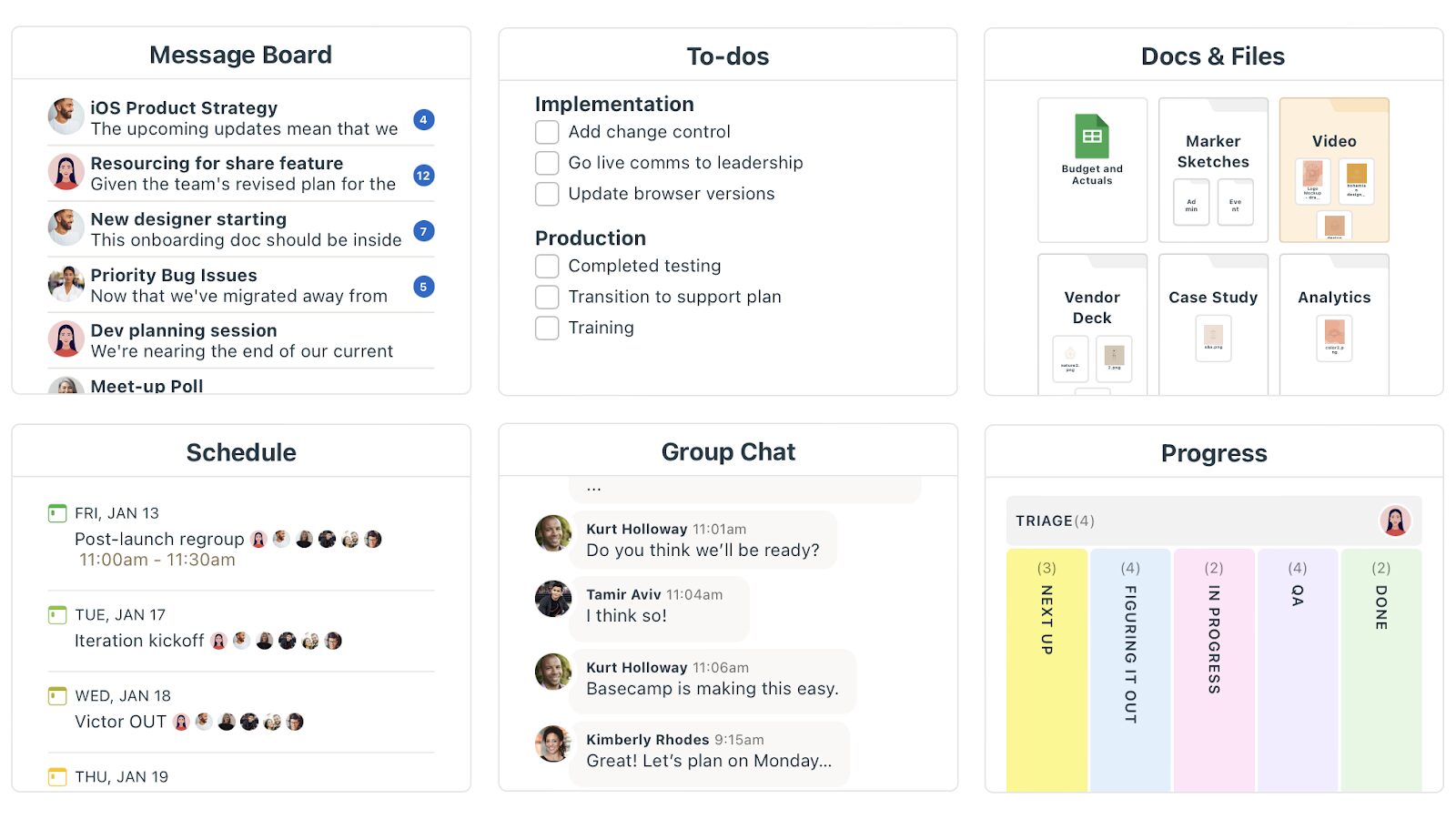
Overview of Basecamp
Basecamp is renowned for its collaboration features, making it perfect for teams that need to stay connected and organized. It combines task management with communication tools to keep everyone on the same page.
Features of Basecamp for Task Management
- Message Boards: Centralize team communications in organized threads
- To-Do Lists: Create, assign, and track tasks with ease
- Schedules: Manage project timelines with shared calendars
- Document and File Storage: Store and share files within the project management software
- Real-Time Group Chat: Use Campfire for quick, informal conversations
#3. Trello: Best Task Management Software for Beginners
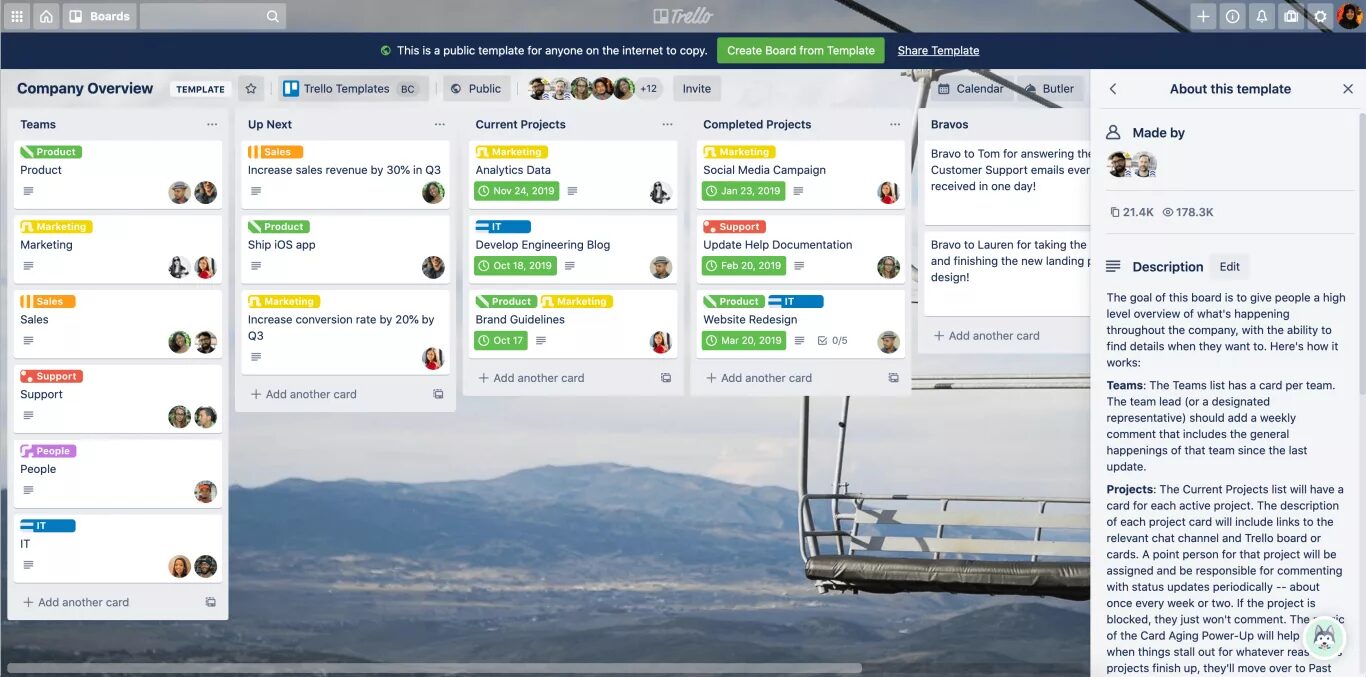
Overview of Trello
Trello uses a visual approach to task management with its board and card system, making it ideal for beginners. It’s simple yet powerful, allowing users to customize workflows to fit their needs.
Features of Trello for Task Management
- Checklists and Due Dates: Break down tasks into smaller steps and set deadlines
- Kanban Boards: Visualize tasks with boards and cards
- Drag-and-Drop Interface: Easily move tasks through different stages of completion
- Customizable Workflow: Adapt Trello boards to fit your unique process
- Integration With Other Tools: Connect Trello with popular apps like Slack, Google Drive, and more
4. Asana: Best Task Management Software for Remote Teams
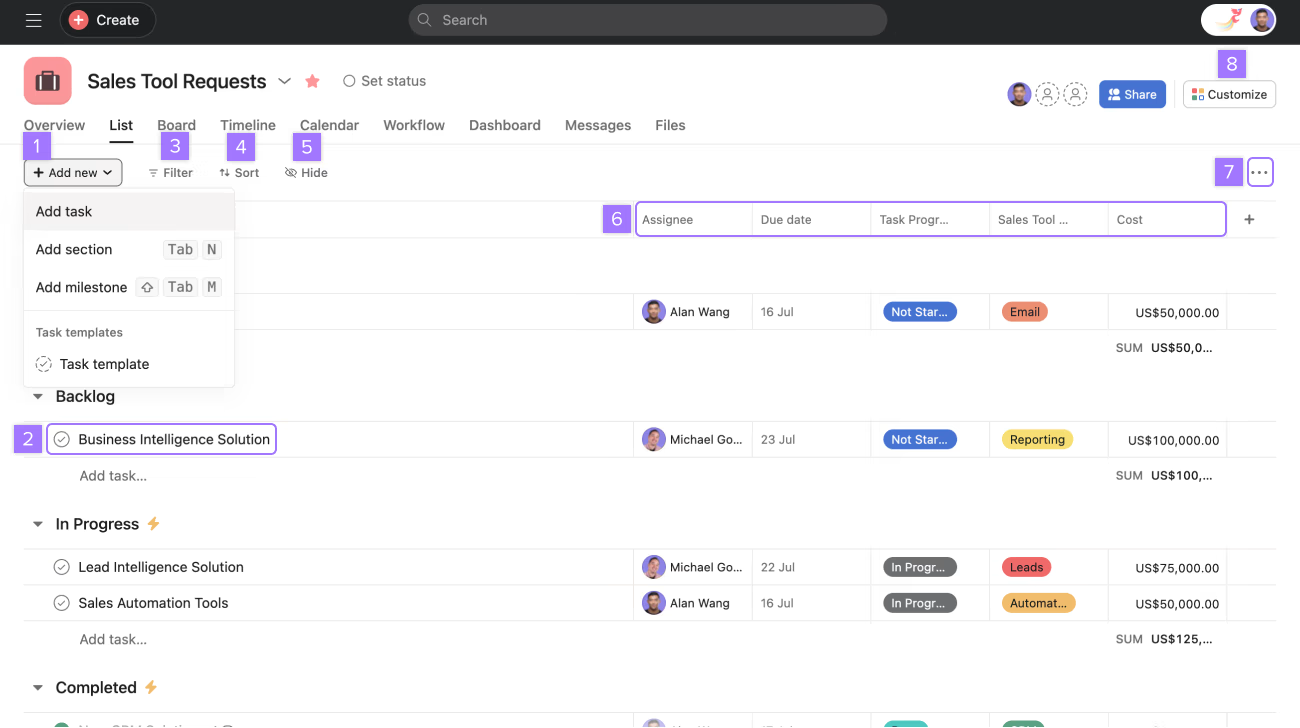
Overview of Asana
Asana is designed to help teams coordinate their work, especially in the management of remote teams. Its flexibility and robust feature set make it a favorite for any task manager.
Features of Asana for Task Management
- Project Timelines: Visualize your project tasks with timelines
- Task Dependencies: Manage task dependencies to avoid bottlenecks
- Workspaces: Organize tasks and projects by teams
- Task and Subtask Management: Break down tasks into smaller, manageable pieces
- Reporting and Analytics: Track project progress and generate reports
#5. ClickUp: Best Task Management Software for Project Planning

Overview of ClickUp
ClickUp offers a comprehensive suite of features for project planning and task management. It’s designed to be an all-in-one tool that adapts to your needs.
Features of ClickUp for Task Management
- Customizable Views: Choose from list, board, box, calendar, and Gantt views
- Task Priorities: Assign priorities to tasks for better focus
- Goals and Milestones: Set and track progress toward project goals
- Time Tracking: Track time spent on tasks directly within ClickUp
- Third-Party Integrations: Seamlessly connect with other tools like Slack, GitHub, and more
#6. Smartsheet: Best Task Management Software for Task Automation
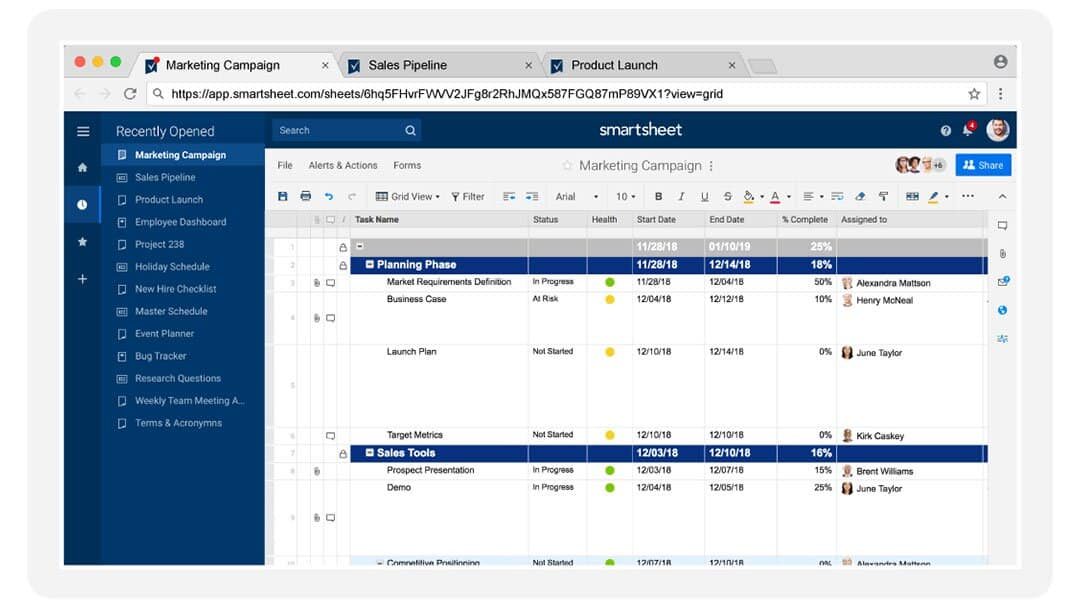
Overview of Smartsheet
Smartsheet is designed for teams that need robust task automation and project management features. It offers a flexible platform for tracking and managing tasks, automating repetitive workflows, and collaborating with team members.
Features of Smartsheet for Task Management
- Resource Management: Allocate resources effectively to optimize team performance.
- Automated Workflows: Automate task assignments and updates.
- Project Tracking: Manage tasks using Gantt charts, calendars, and card views.
- Collaboration Tools: Share sheets, attach files, and comment directly on tasks.
- Reporting and Dashboards: Generate real-time reports and visualize data with dashboards
#7. Todoist: Best Task Management Software for To-Do Lists
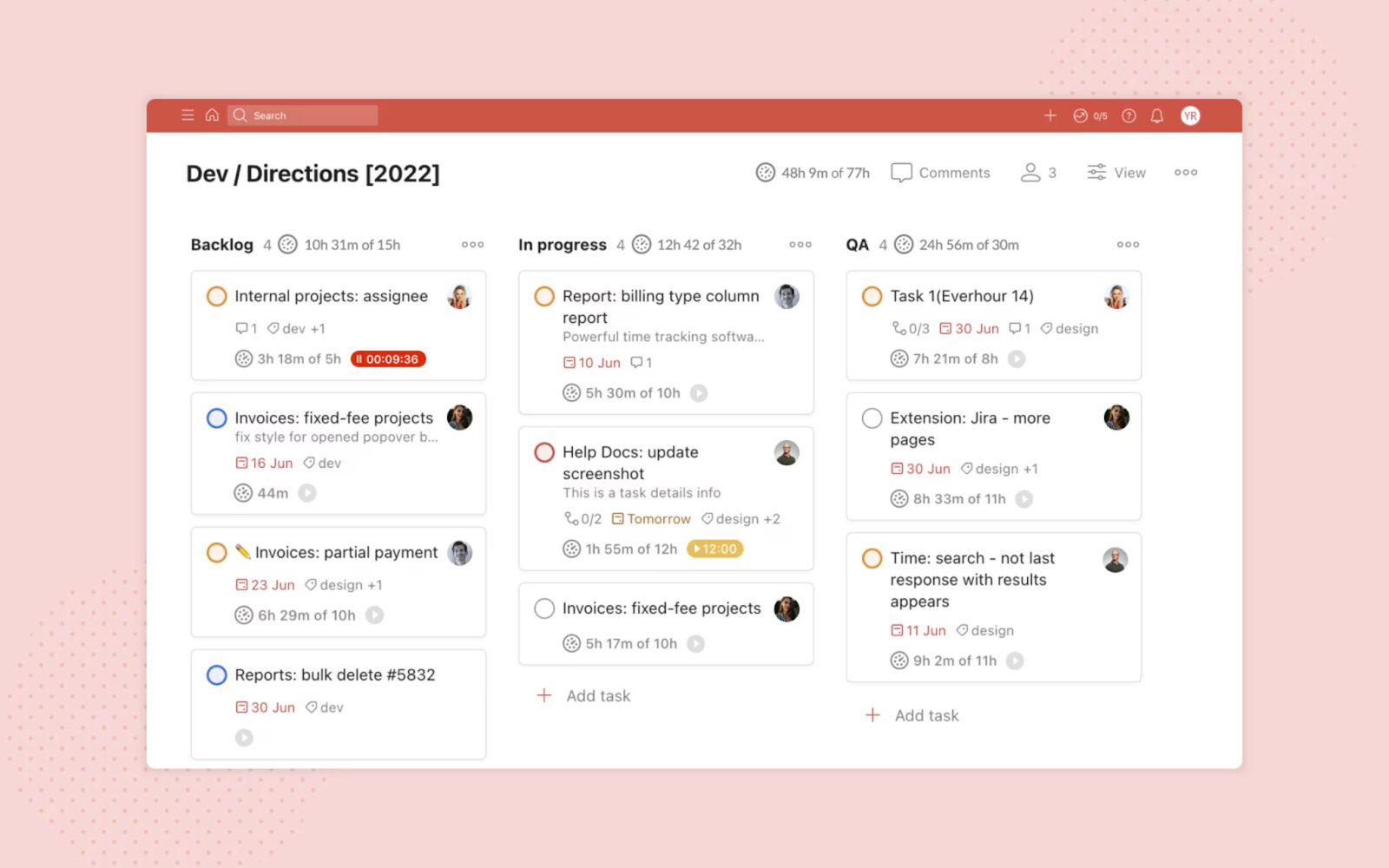
Overview of Todoist
Todoist is perfect for individual tasks and small teams that need a straightforward way to manage to-do lists. It’s user-friendly and offers just the right features to keep you organized without overwhelming you.
Features of Todoist for Task Management
- Task Creation and Organization: Quickly add and organize tasks
- Priority Levels: Set priority levels to focus on the most important tasks
- Project and Sub-Project Management: Organize tasks into projects and sub-projects
- Labels and Filters: Use labels and filters to categorize and find tasks easily
- Collaboration: Share projects and assign tasks to team members
Choosing the right task management app can transform your workflow management and boost productivity. Whether you’re looking for a comprehensive solution like SweetProcess or a simple to-do list manager like Todoist, there’s a tool out there that fits your needs. Ready to take your personal task management skills to the next level? Sign up for the 14-day free trial of SweetProcess and see the difference it can make for your team.
7 Effective Task Management Techniques & Strategies for Success

Over time, experts have demystified the process of managing tasks effectively. Using these techniques and strategies can make all the difference for your organization.
Here are seven proven methods to help you stay on your game.
Pomodoro Technique
The Pomodoro Technique involves working in 25-minute intervals, called “Pomodoros,” followed by a short break. After four Pomodoros, take a longer break. This technique leverages the power of focused work sessions to boost productivity and reduce burnout. It’s like giving your brain a series of sprints rather than a marathon.
Getting Things Done (GTD)
David Allen’s Getting Things Done (GTD) methodology is a game-changer for task management. It involves capturing all tasks and ideas, clarifying what each item requires, organizing them by priority, reflecting on your list regularly, and engaging in the tasks. GTD helps you clear your mind of clutter and focus on actionable items, making it easier to manage your workload effectively.
Eat That Frog
Inspired by Mark Twain’s advice, “Eat a live frog first thing in the morning, and nothing worse will happen to you the rest of the day,” this technique encourages you to tackle your most daunting task first. Addressing the biggest challenge early sets a productive tone for the rest of the day. It’s about building momentum and knocking out the task weighing you down.
The Eisenhower Matrix
Struggling to prioritize tasks? The Eisenhower Matrix can help. This technique involves categorizing tasks into four quadrants based on their urgency and importance:
- Neither urgent nor important
- Urgent and important
- Important but not urgent
- Urgent but not important
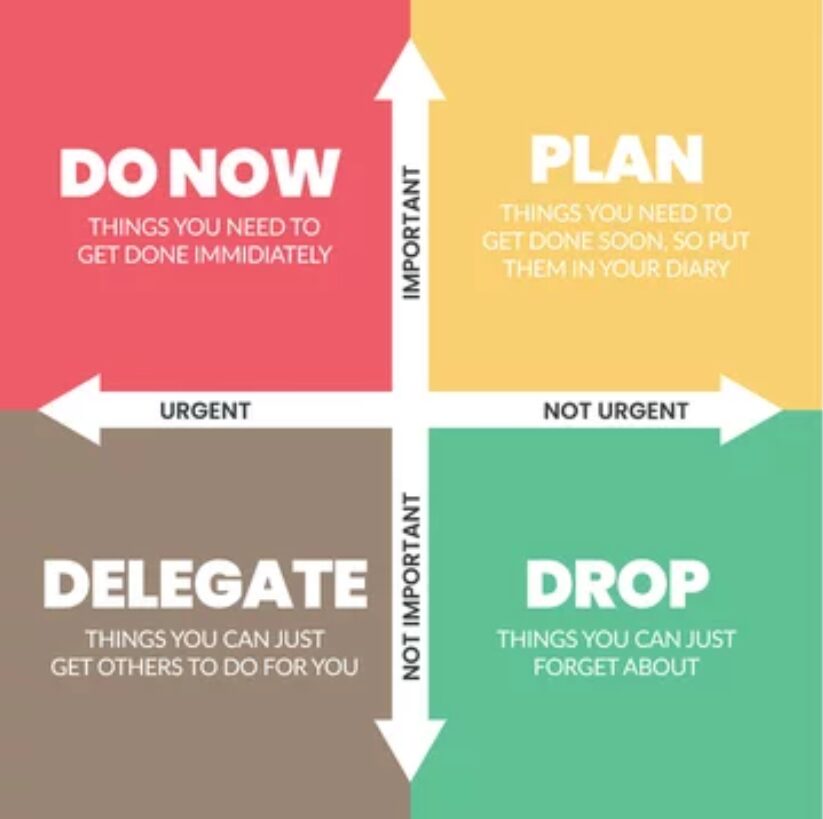
This matrix helps you focus on what truly matters, ensuring you’re not just busy but productive.
Time Blocking
Time blocking is like budgeting for your time. Allocate specific time slots for different tasks or activities throughout your day. This approach helps you focus on one task at a time, reduces procrastination, and ensures that you dedicate enough time to important tasks. It’s like setting up appointments with yourself to get work done.
Task Prioritization
Effective task prioritization is crucial for managing your workload. Use methods like the ABCDE prioritization technique, where tasks are ranked from A (most important) to E (least important) to determine which tasks require immediate attention. Focusing on high-priority tasks first ensures you’re making the most significant impact with time and effort.
Use Kanban for Planning
Kanban is a visual task management tool that uses boards and cards to represent tasks and their stages of completion. It’s perfect for tracking progress and ensuring that work flows smoothly. With columns for your “To Do List,” “In Progress,” and “Done,” Kanban helps you visualize your tasks and streamline your workflow. It’s like having a real-time dashboard of your projects.
Implementing these techniques can transform your approach to task management, making you more efficient and less stressed. Want to take it a step further? SweetProcess offers tools that integrate these strategies seamlessly into your workflow. Sign up for the 14-day free trial to get things more organized.
9 Key Steps in the Task Management Process

Effective task management can include more than checking off boxes. It involves a comprehensive process that ensures each task is completed efficiently and effectively. Let’s walk through the nine key steps in the task management lifecycle.
Task Planning
Everything starts with a plan. Task planning involves identifying what needs to be done, outlining the steps, and setting clear objectives. It’s like drawing up blueprints before building a house. Without a solid plan, tasks can become chaotic and unmanageable. Planning sets the foundation for success.
Task Initiation
Once you have a plan, it’s time to start. Task initiation is about starting the task and ensuring that all preliminary steps are in place. This might involve gathering resources, setting up tools, or notifying team members. It’s the moment when ideas begin to turn into action.
Task Execution
This is where the rubber meets the road. Task execution involves carrying out the planned activities to complete the task. It requires focus, effort, and coordination. Think of it as the construction phase of your blueprint, where each step is carefully executed to bring the project to life.
Task Organizing
Keeping things organized is crucial. Task organizing involves structuring tasks to make them easy to manage and track. This might include breaking down tasks into subtasks, grouping similar tasks together, and setting up workflows. The organization ensures that everything is in its place, making it easier to stay on top of your workload.
Task Assigning
No task management process is complete without assigning tasks to the right people. Task assigning involves delegating responsibilities based on team members’ skills and availability. It’s about matching the right task with the right person, ensuring that each task is handled by someone capable and prepared.
Want to delegate effectively? Here’s an article on how RACI charts help you delegate responsibilities
Task Handling
Task handling refers to the ongoing management of tasks as they’re being worked on. This involves addressing issues that arise, making necessary adjustments, and providing support to team members. It’s about keeping the momentum going and ensuring that tasks progress smoothly.
Task Managing
Task managing is overseeing the entire process, ensuring everything is on track and aligned with the plan. This includes monitoring progress, coordinating efforts, and making strategic decisions. It’s like being an orchestra conductor, ensuring that all parts come together harmoniously.
Task Monitoring and Tracking
Keeping a close eye on progress is essential. Task monitoring and tracking involve regularly checking the task status, identifying any deviations from the plan, and making necessary corrections. This step ensures that you’re always aware of where things stand and can intervene promptly if something goes off course.
Task Reporting
Finally, task reporting involves documenting task outcomes, analyzing performance, and sharing insights with stakeholders. Reporting provides valuable feedback, highlights successes, and identifies areas for improvement. The wrap-up concludes the task and sets the stage for future success.
Mastering these steps ensures a structured approach to task management, leading to successful project completion. Want to streamline this process even further? Sign up for the 14-day free trial of SweetProcess and see how it can enhance your task management workflow.
Task Management vs. Project Management: How They Differ
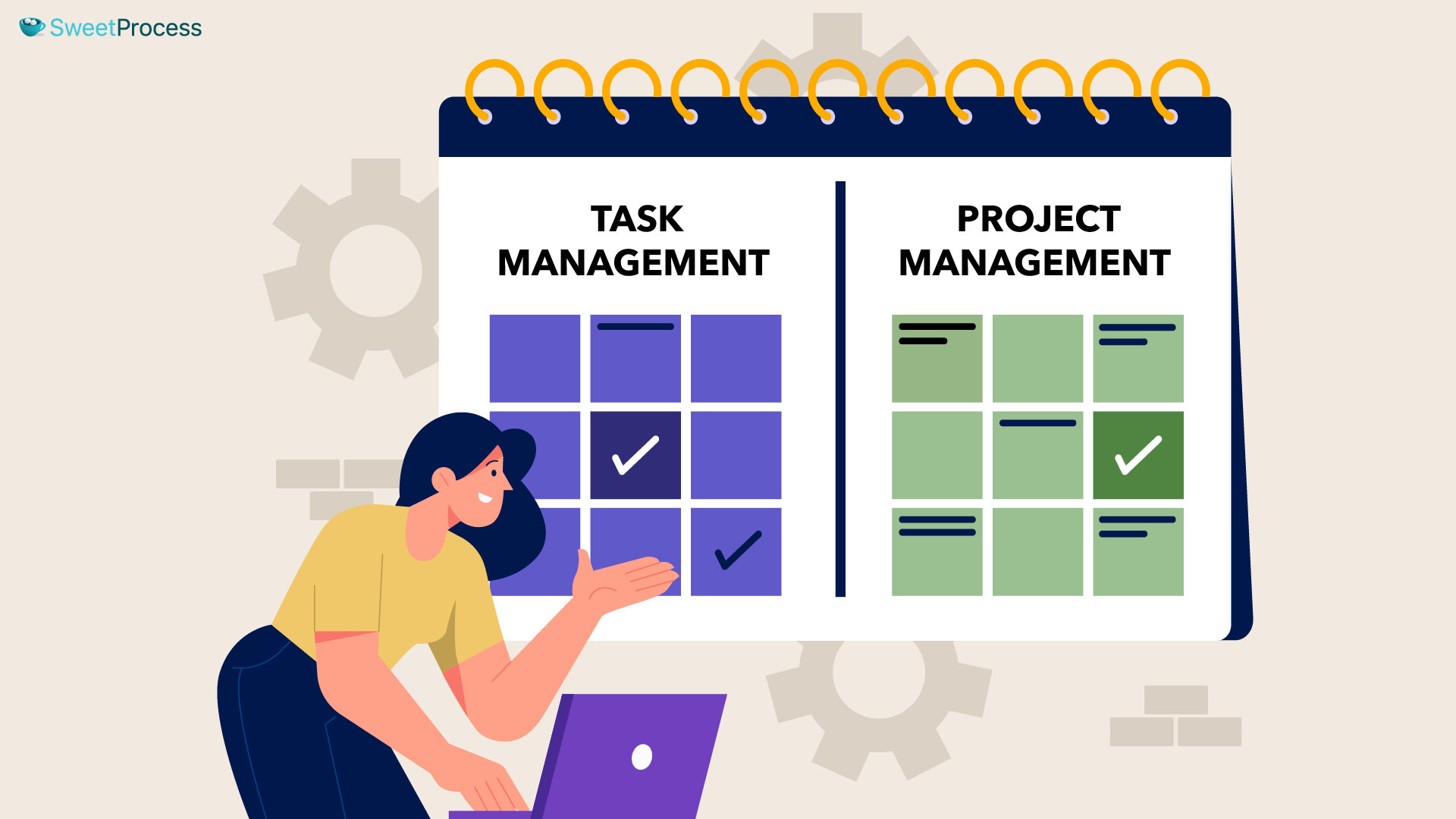
Ever wondered if task management and project management are just two sides of the same coin? It’s a common question, but these terms aren’t interchangeable. Understanding the difference can save you a lot of headaches and improve your workflow significantly.
Task management focuses on tasks involving specific actions needed to achieve a goal. It’s about handling day-to-day activities and ensuring each task is completed efficiently and effectively.
Think of it as managing the puzzle pieces, making sure each piece fits perfectly.
On the other hand, project management is like overseeing the entire puzzle. It’s a broader discipline that involves planning, executing, and closing projects.
It encompasses task management and includes resource allocation, budgeting, risk management, and stakeholder communication.
Project management is about seeing the bigger picture and ensuring all the pieces come together to complete a project successfully.
One key insight? Effective project management relies heavily on solid task management. Without it, projects can quickly go off the rails.
So while they differ in scope, they are deeply interconnected.
Manage Your Company’s Tasks Effectively Using SweetProcess

Effective task management is the cornerstone of a productive and efficient organization. It streamlines workflows, boosts team collaboration, and ensures deadlines are met.
With SweetProcess, you can easily create and assign tasks, manage procedures and processes, and keep track of everything all in one place. It’s like having a personal assistant for your entire team, ensuring everyone knows their roles and responsibilities.
The result? A more organized, efficient, and successful operation.
Think about the peace of mind of knowing all your tasks are handled efficiently. No more late-night worries about missed deadlines or forgotten tasks. SweetProcess streamlines your workflow so you can focus on what truly matters—growing your business and achieving your goals. Ready to see the difference for yourself? Sign up for the 14-day free trial of SweetProcess and start managing your tasks efficiently. Transform your workflow today and watch your business thrive.
